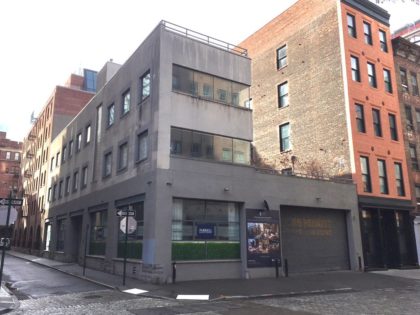In the News: How Congestion Pricing Could Help Downtown
 ••• “A wealthy artist thought $16,300 per month in rent would get her a swanky apartment in Tribeca—but all it got her was an illegal slum, according to court papers. Sheryl Aufrichtig has filed suit against the owner of her former home at 11 Hubert St., claiming the high-end digs were really a dangerous flophouse, with a rodent problem, a front door that never locked and a ceiling that collapsed into one of her bedrooms. The tenant eventually found out that her apartment was actually illegal, as its certificate of occupancy does not permit residential use in the three-story former motor freight terminal, according to the suit against Aufrichtig’s landlord, Adam Zoia; broker, Andrew Azoulay and real estate firm, Douglas Elliman.” —New York Post
••• “A wealthy artist thought $16,300 per month in rent would get her a swanky apartment in Tribeca—but all it got her was an illegal slum, according to court papers. Sheryl Aufrichtig has filed suit against the owner of her former home at 11 Hubert St., claiming the high-end digs were really a dangerous flophouse, with a rodent problem, a front door that never locked and a ceiling that collapsed into one of her bedrooms. The tenant eventually found out that her apartment was actually illegal, as its certificate of occupancy does not permit residential use in the three-story former motor freight terminal, according to the suit against Aufrichtig’s landlord, Adam Zoia; broker, Andrew Azoulay and real estate firm, Douglas Elliman.” —New York Post
••• Alleged “Tip-Jar Bandit” caught red-handed at Kung Fu Tea. —SILive
••• “No part of the city will benefit more than Lower Manhattan,” wrote Charles Komanoff in an op-ed for The Villager about the Fix NYC plan for congestion pricing. “Three East River bridges connect Brooklyn with Downtown Manhattan, and a fourth connects Queens with Midtown. For nearly a century, the failure to toll these bridges has led drivers to pour onto our streets to reach destinations served by multiple subway lines or to pass through to New Jersey. My [Balanced Transportation Analyzer] model forecasts that the robust congestion charges outlined in the Fix NYC report will cut traffic volumes on those bridges by 25 percent. The reduction will reach 35 percent as subway improvements paid for by the tolls draw even more trips out of automobiles. In plain numbers, the 25 percent reduction equates to 10,000 fewer trips in each direction each weekday on each East River bridge. Picture Canal, Broome, Delancey, Chambers, Walker and Varick Sts. and our other ‘traffic sewers’ with thousands fewer cars and trucks.”
••• Eben Lillie, son of Chambers Street Wines co-founder David Lillie, on what it has been like working at the store and how he came to love the wine business himself. —Munchies
••• “The Regional Plan Association—an independent, not-for-profit civic group that develops ideas to improve the economy, environment, and quality of life in the New York metropolitan area—is calling upon the City to repeal its Floor Area Ratio cap. This limit, which currently restricts residential buildings to a total square footage of 12 times the size of the lot on which the structure is located, was enacted in 1961, in an effort to prevent developers from creating, ‘large vertical slums that would be health hazards and overwhelm the urban infrastructure,’ according to the RPA’s new report [….] If such a policy were adopted, Lower Manhattan would be among the areas where its impact would be most dramatic, according to the report, which predicts more development of affordable units—under the City’s Mandatory Inclusionary Housing law—as designs for new residential buildings were permitted to become taller and bulkier.” What a disastrous idea. —Broadsheet
















Only someone who has no car and doesnt drive to downtown. Would think this. I drive to Manhattan downtown 2 days a week Saturday & Sunday morning and home when work is over.
Also if i work overnight. “The lack to add tolls on the bridges” more from a person who doesnt drive NYC residents are excessively taxed via tolls.
” Traffic has become an urban scourge, and not only in New York. Around the world, it is a drag on economic activity and the quality of life. People waste hours in it, all the while sending pollution into the air. […]
” Traffic is a classic ‘tragedy of the commons’ problem. The phrase comes from the ecologist Garrett Hardin, based on work by the 19th-century economist William Forster Lloyd.
” Lloyd described British villagers sharing a plot of land where their cattle could graze. Any individual benefited from using the land as much as possible. But if they all maximized use, they could destroy the grass.
” The space on city streets is like the village common. When it’s overused, it becomes less valuable to everyone.
” The good news is that modern societies have developed a solution to the tragedy: Charge money to use the commons. Doing so not only discourages overuse, it also raises funds that can solve the larger need — to grow another field where cows can graze, say, or to build a well-functioning subway system. And, yes, I realize that both grazing cows and well-functioning subways sound far-fetched to today’s New Yorkers.
“The charge for using clogged roads is known as ‘congestion pricing,’ and it works well where it has been tried, like London, Singapore and Stockholm. In New York, the daily charge to drive below 60th Street might be around $8, with additional charges for vehicles that linger all day.
“Ken Livingstone, the London mayor when congestion pricing began in 2003, has said it’s the only thing in his political career that ‘turned out better than I expected.’ […]
“The reason more cities haven’t adopted congestion pricing, Livingstone says, is ‘political cowardice.’ People cling to the idea that driving should be free, even though it imposes big costs on others.
[…]
“I understand why politicians are afraid to support congestion pricing. We all like the idea of a free lunch — or a free road. But political leadership is supposed to be just that: leadership. It involves making tough decisions for the common good and winning over citizens.”
“How to Get New York Moving Again” https://www.nytimes.com/2018/01/07/opinion/new-york-traffic-cuomo.html
Agreed!
cannot agree on all of these suggestions unless downtown residents are exempt from the additional fees. If you go often or work at any of the larger east side hospitals like Memorial Sloan Kettering or NYP Cornell Hospitals or even the Animal Medical Center you will be charged ridiculously by car or cab. The Downtown Branch of NYP cannot handle many situations and you have to be transferred uptown – so financial pain is added on top of medical ills.
In London, I understand residents get up to a 90% discount if they prove residency in the zone AND prove their car is registered with the government’s Motor Vehicle Registry to their address within the zone.
I am sure that it will be a hard choice for many certain Manhattan car-owning residents whether to keep their car (illegally) registered with the DMV at a 2nd home outside NYC for lower insurance rates or whether to register their car with NYS DMV in Manhattan properly for the congestion zone pricing discount.
(Manhattan residents already get a substantial parking tax discount.)
There have to be other options…Commuter tax anyone? Why add another tax to residents in lower Manhattan?! What about a infrastructure tax on developers? What about not penalizing people who live and work and drive down here and are not millionaires?
None of those tax options do what congestion pricing does, namely reduce car traffic. Congestion pricing makes drivers pay just a part of the cost that everyone incurs from traffic and auto pollution. It is a drag on our economy and wastes tremendous amounts of people’s time.
Right now, more people drive than should because the cost to drive is artificially low (like free or cheap on-street parking vs. the cost of garage parking). If driving into Manhattan is not worth the daily fee, than maybe you should be taking mass transit instead, or maybe do not use Canal Street as a toll-free highway from the bridge to the Holland Tunnel.
All those taxes do, at best, is raise money. Even if we use some of it for mass transit, too many cars will still be on the road in the absence of congestion pricing. We cannot use that money to build more streets to handle more cars, because there is no room to build more streets in Manhattan.
From the Report – Fix NYC Advisory Panel – Jan 2018
“Moreover, those who choose to highlight these proposals as regressive also choose to ignore the facts. Census data indicate that only four percent of outer borough working residents commute to jobs in Manhattan in a vehicle, or approximately 118,000 residents. Of those 118,000, more than half are higher income individuals, more than a quarter are moderate-income individuals and less than 5,000 of them qualify as working poor. Compare those numbers to the 2.2 million New York City residents, including 190,000 of the working poor, who rely on mass transit to get to work day in and day out, and who would benefit from transit improvements paid for by the zone pricing plan. Consideration should be given to a tax benefit for these lower income commuters most impacted by the pricing zone who have no choice but to commute in vehicles.”
The plan calls for variable rates of $5.50 for off hours on weekends and late night, $8.50 for prime time and $11.50 for rush hours of 6am to 9am weekdays.
But these plans first require that all the current traffic laws be enforced, that For Hire Vehicles pay a surcharge in the zone and that trucks pay a 2x amount over cars.
Cars would be the last phase and not for years to come.
Read the report here – http://www.hntb.com/HNTB/media/HNTBMediaLibrary/Home/Fix-NYC-Panel-Report.pdf
Yes to congestion pricing!
Use the income to develop and subsidize better mass transit options.
Yes, because the MTA and as well as NYC & State Government have proven so efficient at budgeting and spending money efficiently… sure, let’s give them EVEN MORE money to blow. James lays out great points, and overall, the theory of congestion pricing is very appealing. London appears to have even benefitted somewhat from it. My biggest concern is that there is ZERO accountability at the MTA, NYC & NY state government level for their total mismanagement and (let’s be honest here) utter corruption. Make no mistake, the congestion pricing is a wonderful idea that appeals to reasonable people’s sense… but it is nothing more than a cash grab so that the powers that be can mask their own incompetence.
The MTA & other entities need to get their act together and actually prove they can make real improvements versus just putting lipstick on the pig. If they don’t do this first, the congestion pricing will be nothing more than just a tax whose proceeds go into a black hole with no real benefits ever seen. Again.
While we are finally considering ways to address the massive quality-of-life costs of cars on urban life, I’ll dream bigger:
– let’s enforce laws against non-emergency horn honking
– let’s finally ban car alarms
– let’s enforce laws against red-light running, speeding, blocking “the box”, etc…
Great to see these supportive comments, especially James’s, which nail it!
Victor: tolls will be lower for off-peak trips into the “congestion zone,” so your trips on Saturday & Sunday mornings will be charged a lot less than full freight.
Re your belief that “Only someone who has no car and doesn’t drive to downtown” would support congestion pricing, that describes a majority of NYC households — the vast majority, for the “doesn’t drive downtown category.” But every HH depends on our subways, which congestion pricing will help improve. Let’s try to think of the greater good, as James suggested.
We live in lower Manhattan, own two vehicles and absolutely support congestion pricing. With the mass transit options available, there’s no reason to routinely drive in Manhattan. We must do something to reduce the traffic volume in order to improve air quality and emergency response times.
Simply blaming congestion issues on the number of cars is avoiding the root causes. Are people willing to look at themselves in the mirror? Do you use Uber, Lyft, or another ride sharing service? They contribute to congestion. “People don’t shop locally anymore” is a common complaint as online shopping has skyrocketed in recent years. All those purchases are delivered by more UPS, FedEx and USPS vehicles than ever before. They contribute to congestion. I see Fresh Direct trucks and the Whole Foods delivery vans all over. Your online grocery shopping contributes to congestion. Many bike lanes narrow many streets which contributes to congestion. The perceived demand for more glass box apartments create construction zones that contribute to congestion by blocking or narrowing streets. The population downtown has greatly increased with more workers, residents, students, and tourists. Watch the large packs of people crossing the street at major intersections. Waiting longer to turn your vehicle increases congestion. The Governor’s Fix NYC plan, which raises congestion pricing as a needed fix states that “in 2008, the number of cars crossing into Manhattan from outer boroughs was peaking; it has since declined. Now, the intense growth is the number of vehicles within the core of Manhattan.” That’s a lot of conveniences driving around. If congestion pricing is introduced, ride sharing services, and all the aforementioned delivery services will pass the cost onto their customers and then the same people demanding congestion pricing will be complaining about the increased amounts they are paying for their conveniences. Even if you don’t own a car, you will indirectly be paying the congestion pricing tolls. There isn’t any simple solution.